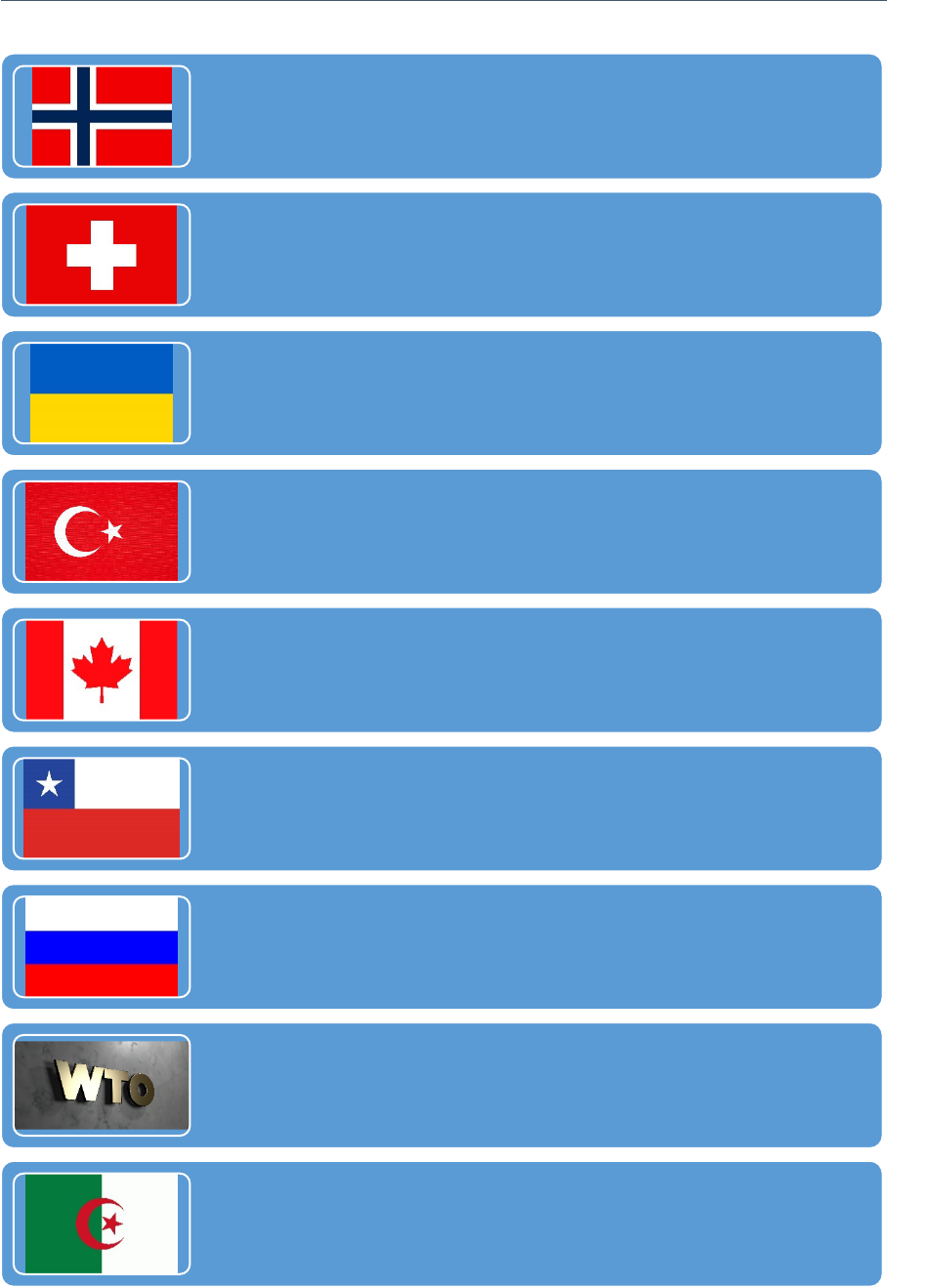
IN-DEPTH ANALYSIS
EPRS | European Parliamentary Research Service
Author: Jana Titievskaia
Members' Research Service
PE 642.229 – October 2019
EN
EU trade policy
Frequently asked
questions

This paper seeks to serve as a key resource for policy-makers who need to understand complex issues related
to international trade quickly. It also outlines the key academic debates and thorny issues and provides
references to potentially useful further resources. The paper does not cover the state of play of trade
negotiations or legislative files as these are covered in other EPRS publications.
The Legislative Train Schedule for trade monitors progress on key legislative files and trade agreements on a
monthly basis.
EPRS publications on international trade include short 'at a glance' notes on topical trade issues and
'international agreements in progress' briefings, as well as longer, more in-depth papers.
AUTHOR(S)
Author: Jana Titievskaia, Members' Research Service. Graphics by the author.
This paper has been drawn up by the Members' Research Service, within the Directorate-General for
Parliamentary Research Services (EPRS) of the Secretariat of the European Parliament.
To contact the authors, please email: [email protected]pa.eu
LINGUISTIC VERSIONS
Original: EN
Translations: DE, FR
Manuscript completed in September 2019.
DISCLAIMER AND COPYRIGHT
This document is prepared for, and addressed to, the Members and staff of the European Parliament as
background material to assist them in their parliamentary work. The content of the document is the sole
responsibility of its author(s) and any opinions expressed herein should not be taken to represent an official
position of the Parliament.
Reproduction and translation for non-commercial purposes are authorised, provided the source is
acknowledged and the European Parliament is given prior notice and sent a copy.
Brussels © European Union, 2019.
Photo credits: © 9dreamstudio / Fotolia.
PE 642.229
ISBN: 978-92-846-5673-8
DOI:10.2861/583720
CAT: QA-01-19-761-EN-N
[email protected]ropa.eu
http://www.eprs.ep.parl.union.eu (intranet)
http://www.europarl.europa.eu/thinktank (internet)
http://epthinktank.eu (blog)

EU trade policy
I
Executive summary
The EU's common commercial policy (CCP), or trade policy, has evolved gradually over the years to
encompass a range of trade-related areas under the remit of European Union (EU) exclusive
competence. The Treaty of Rome established the common market and the customs union with a
focus on goods. Later treaties expanded the CCP to services and commercial aspects of intellectual
property rights. Trade policy falls under the EU's exclusive competence, meaning that the EU
manages trade policy and trade negotiations on behalf of the Member States. The determination of
competence is critical for the procedures needed to conclude trade agreements, as in areas falling
under shared competence these need to be ratified by both the EU and Member States. This has
led to trade and investment agreements being split into two parts to speed up the ratification
process for the trade parts, following European Court of Justice (ECJ) Opinion 2/15 (Singapore).
Whereas trade liberalisation is generally accepted to lead to economic growth, the impact on jobs
varies both between and within countries. According to the European Commission, in 2018 trade
supported 36 million export-related jobs. Trade can also lead to more inequality, however, in
particular by widening the gap between skilled and unskilled workers or in causing the unequal
relationship between developed and developing countries to become more entrenched.
Trade liberalisation in its most basic form involves the removal of tariffs, which are taxes or duties
to be paid for an import. Tariff rate quotas charge lower rates within a certain quota, jumping to a
higher tariff rate after the quota is exhausted. Tariffs are cut under World Trade Organization (WTO)
agreements, with the most-favoured nation tariff representing the highest possible tariffs that WTO
members can charge each other. In contrast, preferential tariffs are agreed to in trade agreements
or customs union arrangements. Rules of origin have been developed in order to determine where
goods originate from (or the 'economic nationality' of products). These rules are all the more
important in the era of global value chains, where a significant proportion of European products'
value comes from foreign sub-components or services.
Trade liberalisation also seeks to remove non-tariff barriers (NTB) to trade, these include
protectionist measures to help domestic producers, subsidies, technical barriers to trade, or
stringent sanitary and phytosanitary requirements. Lower NTBs can facilitate cross-border trade in
services, which play a huge role in overall EU trade. However, data collection and measurement
issues complicate efforts to understand the services trade. Trade defence instruments, meanwhile,
enable the EU to react, for instance, to dumping or WTO-incompatible subsidies in partner trading
countries, and form the protective front of EU trade policy.
The CCP focuses on fostering fair and free trade, furthering market access and supporting the
multilateral, rules-based trading system. To achieve these objectives, the EU employs a range of
legislative tools and negotiates trade agreements with trade partners. More specifically, over recent
decades the EU has aimed to spread open and free trade based on mandates from Member States.
After the breakdown of the WTO Doha Round, the EU initiated a period of concentrated focus on
free trade agreements, which tackle both tariff liberalisation and NTBs, with a wide range of partner
countries from America to Asia.
The EU has concluded trade agreements on multilateral, plurilateral and bilateral bases. EU trade
agreements are adopted through a lengthy procedure, which involves distinct stages, namely
preparation, a mandate to open talks, negotiations, textual agreement, initialling, signature,
provisional application and, finally, entry into force. The EU also offers different types of trade
relationship, ranging from deep integration on both regulatory and trade fronts, to simple

EPRS | European Parliamentary Research Service
II
partnership and cooperation agreements that do not offer preferential treatment. Trade
agreements are enforceable through a dedicated dispute settlement mechanism that allows
parties to adopt economic remedies in the event of non-compliance. However, certain provisions in
trade agreements, such as trade and sustainable development (TSD) clauses, have a different
mechanism for settling disagreements that involves government consultations and
recommendations issued by a panel of experts. Efforts to make trade policy 'greener' include TSD
chapters, but also provisions to support sustainable use of natural resources, biodiversity, forestry
and fisheries. Trade agreements also include human rights clauses that aim to incentivise trade
partners to improve internal governance.
EU trade legislation is adopted under the ordinary legislative procedure, and provides the
framework for trade policy. Since the Lisbon Treaty, the European Parliament has played an
important role in the CCP. Parliament must give its consent to trade agreements or trade-related
legislation, while it also monitors trade policy developments through resolutions, hearings and
workshops. The European Commission proposes and negotiates, while the Council authorises the
opening of negotiations and decides on the conclusion of trade agreements. Civil society and
stakeholders are encouraged to feed into this process on a regular basis.
Where technocratic negotiations were once sufficient, trade policy has undergone intense
politicisation in recent years. Where trade policy used to be characterised by material arguments
based on numerical simplicity, now it features normative disagreements and regulatory politics. This
makes knowledge and understanding of the complex concepts and themes of EU trade policy all
the more important.

EU trade policy
III
Table of contents
1. Introduction _________________________________________________________________ 5
2. Background: evolution and scope of the common commercial policy ___________________ 5
2.1. The common commercial policy: from coal and steel to services and foreign direct investment
____________________________________________________________________________ 5
2.2. Evolution and scope of trade competences ______________________________________ 8
3. Economics of trade ____________________________________________________________ 9
3.1. Does trade lead to economic growth in the EU? __________________________________ 9
3.2. Does trade create or cut jobs in the EU? ________________________________________ 10
3.3. Does trade lead to inequality in the EU? ________________________________________ 11
4. Key trade concepts ___________________________________________________________ 12
4.1. How do tariffs work? _______________________________________________________ 12
4.2. What are rules of origin? ____________________________________________________ 13
4.3. What are non-tariff barriers to trade? __________________________________________ 13
4.4. How are services traded? ____________________________________________________ 14
5. Formulation of EU trade policy _________________________________________________ 15
5.1. What are the aims of EU trade policy? _________________________________________ 15
5.2. What are the roles of EU institutions in trade policy? _____________________________ 16
5.2.1. What does the European Parliament do? ____________________________________ 16
5.2.2. What does the European Commission do? ___________________________________ 16
5.2.3. What does the Council do? _______________________________________________ 16
5.3. How is civil society involved in EU trade policy? _________________________________ 17
6. EU trade-related legislation ____________________________________________________ 18
6.1. What are the different EU laws relating to trade? ________________________________ 18
6.2. What are trade defence instruments? __________________________________________ 19

EPRS | European Parliamentary Research Service
IV
6.2.1. What are anti-dumping duties? ____________________________________________ 19
6.2.2. What are anti-subsidy measures? __________________________________________ 19
6.2.3. What are safeguard measures? ____________________________________________ 20
7. International trade agreements and negotiations __________________________________ 20
7.1. What are trade agreements? _________________________________________________ 20
7.2. How does the EU negotiate at multilateral level in the WTO? _______________________ 20
7.3. How does the EU conclude trade agreements? __________________________________ 22
7.4. What are the different types of EU trade relationships? ___________________________ 23
7.5. Are trade agreements enforceable? ___________________________________________ 25
8. Trade and sustainable development _____________________________________________ 25
8.1. How does the EU support sustainable development through its FTAs? _______________ 25
8.2. How are TSD chapters implemented and enforced? ______________________________ 27
8.2.1. Should the TSD chapter be subject to a general or a dedicated dispute settlement?__ 27
8.2.2. Should the EU shift to a sanction-based model for TSD chapters? _________________ 27
8.3. What does a green trade policy include? _______________________________________ 28
8.4. Do trade agreements have human rights clauses? _______________________________ 29
Table of figures
Figure 1 – EU procedure for making trade agreements ________________________________ 22
Figure 2 – Levels of depth of EU trade agreements with various partners _________________ 24

EU trade policy
5
1. Introduction
This paper charts the development of EU common commercial policy over the course of six decades,
from the Treaty of Rome to the Lisbon Treaty (Section 1.1). This development has not taken place
without controversy, as explained in Section 1.2 on the evolution and scope of trade competences.
Basic questions relating to the economics of trade in the EU are discussed in the second chapter:
these include an exploration of whether trade leads to growth (Section 2.1.), what are the effects of
trade on employment (Section 2.2.), and whether trade leads to inequality (Section 2.3.).
Chapter 3 unpacks key trade concepts such as tariffs on trade in goods, rules of origin, non-tariff
barriers to trade, and trade in services.
The aims of EU trade policy (Section 4.1.) and its formulation (Section 4.2.) are charted in Chapter 4.
Each EU institution plays a designated role in concluding trade agreements. Parliament (Section
4.2.1) is a co-legislator for trade alongside the Council (Section 4.2.3.), while the Commission (Section
4.2.2.) proposes trade legislation and negotiates on behalf of Member States. Civil society and
stakeholder involvement (Section 4.3.) is institutionalised through specific dialogues.
Chapter 5 outlines out the range of EU trade-related legislation (Section 5.1), including trade
defence instruments (Section 5.2.), which make up the protective side of EU trade policy. The next
chapter explains international trade agreements (Section 6.1.), and how they are achieved at
multilateral level (Section 6.2.) and at EU level (Section 6.3), is explained. The various types of trade
relationship (Section 6.5.) that the EU can offer trade partners and the enforceability of trade
agreements (6.5.) are also covered.
The final chapter discusses an aspect of trade policy that has been particularly important for the
European Parliament: trade and sustainable development. EU free trade agreements include a wide
range of provisions that can support sustainable development chapters (Section 7.1.). The
enforcement of the trade and sustainable development provisions (Section 7.2.) and the possibility
of a sanctions-based model (Section 7.3.) is a matter of contention. Finally, the paper covers the
specific provisions that aim to make trade policy greener (Section 7.4.) and human rights clauses in
trade agreements (Section 7.5.).
2. Background: evolution and scope of the common
commercial policy
2.1. The common commercial policy: from coal and steel to
services and foreign direct investment
The European Coal and Steel Community (ECSC) was the first step taken by the six founding
members (France, West Germany, the Benelux countries (Belgium, the Netherlands, Luxembourg),
and Italy) towards European integration and a common commercial policy (CCP). The Treaty
establishing the ECSC (signed in Paris in 1951) created a common market for the strategic
industries of steel and coal in the post-war context and introduced the free movement of products
without customs duties or taxes between the territories of the signatory states. The Treaty abolished
and prohibited import and export duties, quantitative restrictions and discriminatory measures, as
well as subsidies, State aid or special charges. The Treaty also set up the predecessor to today's

EPRS | European Parliamentary Research Service
6
European Commission in the form of a common High Authority, which supervised the market,
monitored compliance, and ensured price transparency.
1
The Treaty of Rome, or the Treaty establishing the European Economic Community (EEC), was
signed in 1957 and became effective as of 1958. It established the EEC and a common market,
beyond coal and steel, which was based on four freedoms: the free movement of people, goods,
services, and capital.
2
In practice, the CCP emerged gradually during the 12-year transition period,
intended to smooth the establishment of the common market (1957-1969), and has continued to
evolve since.
3
A CCP was necessary because the Treaty of Rome also created a customs union, which covered
all trade in goods, abolished customs duties or equivalent charges between Member States, and set
up a common external customs tariff.
4
This was in line with the General Agreement on Tariffs and
Trade (GATT), a multilateral agreement on trade in goods – the predecessor to the World Trade
Organization (WTO). The GATT had entered into force in 1948 and required that a customs union
internally remove customs duties and quantitative restrictions on trade in goods between members,
and externally adopt the same common customs tariff in relation to third countries. Without the
common approach to trade embodied in the CCP, the European Community would have faced free-
rider problems, for instance if third country exporters entered the internal market through the
Member State where the tariffs were lowest and then took advantage of free movement across the
territory
5
. To manage this, Members States needed to pool their resources and transfer part of their
trade competences to the supranational level. The aim behind the creation of the CCP was also to
increase the Community's international bargaining power and leverage vis-a-vis third countries.
In practice, the CCP meant that common customs duties were to be fixed by the Council based on a
proposal from the Commission, which would also carry out other tasks entrusted to it.
6
The
Commission would submit the Council proposals for implementing the CCP, recommend the
opening of negotiations and then conduct them; this is still the case today.
The CCP became vital following the expansion of international trade in the 1970s, enlargements,
and the consolidation of the single market in 1986, to ensure EU competitiveness in a globalising
world. In the 1971 landmark judgment Commission of the European Communities v Council of the
European Communities on the European Agreement on Road Transport (ERTA), the European Court
of Justice (ECJ) introduced its famous 'implied powers doctrine', enabling the Community to
negotiate and conclude external agreements over a whole range of its broadly defined objectives.
7
It made this power potentially exclusive by delimiting the Member States autonomous powers on
the international scene to the benefit of the Community. The textual expression of this doctrine is
in Article 3(2) of the Treaty on the Functioning of the European Union (TFEU), which provides that
the EU shall have 'exclusive competence for the conclusion of international agreements – in so far as its
conclusion may affect common rules or alter their scope'. In 1979, the ECJ issued an opinion on the
1
ECSC Treaty, Article 4. See the summaries of EU legislation.
2
Originally Article 3 of the Treaty establishing the European Community (TEC), currently Article 26 of the Treaty on the
Functioning of the European Union (TFEU
). N.B.: whenever appropriate, references are made to TFEU, which originated
as the Treaty of Rome, and forms the consolidated basis of EU law.
3
Articles 110-116, Treaty of Rome.
4
Articles 28-32, TFEU.
5
A. Staab, The European Union Explained – Institutions, Actors and Global Impact, Indiana University Press. 2013,
Chapter 15.
6
Articles 31-32 TFEU.
7
ECJ Case 22/70, European Agreement on Road Transport.

EU trade policy
7
International Agreement on Natural Rubber, in which it interpreted the Community competences
widely under the Treaty of Rome, stating that the Community should be able to formulate a
commercial 'policy', and not merely administer measures such as customs and quantitative
restrictions.
8
Significant multilateral-level developments took
place in the 1990s, when the focus of external
trade shifted from goods, in particular industrial
products, to encompass further areas. The WTO
was established and multilateral treaties on
services, public procurement and intellectual
property were developed. It became increasingly
important to bring these areas under qualified-
majority voting (QMV) and therefore transfer
sovereignty to the supranational level to address
radical changes to the structure of the global
economy. Against this backdrop, in 1997, the
Treaty of Amsterdam included a new ('fast-
track') provision that allowed the Council, acting
unanimously and after consulting the
Parliament, to extend the CCP to agreements
concerning services and intellectual property at
a future date without amending the Treaties.
9
The Treaty of Nice further added that
institutional provisions of the CCP would also
apply to the conclusion of international
agreements in services and commercial aspects
of intellectual property (IP), except for agreements relating to trade in cultural, audio-visual,
educational, social and human health services, which would remain within the shared competence
of the Community and its Member States.
10
The Treaty of Nice also provided for international
agreements in the field of transport to remain outside the CCP.
11
The Treaty of Lisbon (or Lisbon Treaty), which came into force in 2009, granted substantially more
power in trade policy to the European Parliament. With an expanding trade agenda, it was important
to enhance democratic legitimacy in the policy area by increasing Parliament's role. Parliament
became a full-fledged co-legislator in the area of trade, having to give its consent to the conclusion
of trade agreements and adopt trade legislation under the ordinary legislative procedure.
12
Article 207 TFEU forms the basis of EU external trade policy today. It extended the CCP to cover all
trade in goods and services, the commercial aspects of intellectual property, as well as foreign direct
investment (FDI). With the Lisbon Treaty, all four modes of supply for trade, as defined in the General
Agreement on Trade in Services (GATS) fell under the CCP. The Lisbon Treaty also reformed the
EU's external policy and recognised the interlinkage between foreign policy and international trade.
This meant that the CCP has to abide by the same principles as the EU's external action, and resulted
8
Opinion 1/78.
9
Treaty establishing the European Community (Amsterdam consolidated version), Article 133(5) (ex. Article 113).
10
Article 133(5) TEC (Nice consolidated version).
11
Article 133 TEC, ibid.
12
L. Van den Putte, F. De Ville, J. Orbie, The European Parliament's New Role in Trade Policy: Turning power into impact,
CEPS Special Report No 89, May 2014.
Key treaty developments for EU trade
ECSC Treaty, or the Treaty of Paris (signed in
1951, in force from 1952 to 2002), created a
common market for coal and steel, which was
integrated into the Treaty establishing the
European Community after expiry.
Treaty of Rome (signed in 1957, in force since
1958), establishing the European Economic
Community (EEC), created the common market
beyond coal and steel, based on four freedoms,
and the customs union.
Treaty of Amsterdam (signed in 1997, in force
since 1999) and Treaty of Nice (signed in 2001, in
force since 2003) added provisions furthering the
inclusion of services and commercial aspects of
intellectual property rights (IPR) in the CCP.
Treaty of Lisbon (signed in 2007, in force since
2009), is known in its updated form as the Treaty
on the Functioning of the EU (TFEU), and forms
the constitutional basis for the EU and its
exclusive trade competence today.

EPRS | European Parliamentary Research Service
8
in a need to enhance coordination between the EU's foreign and trade policy goals. In practice, this
meant close cooperation in particular between the European External Action Service (EEAS) and the
European Commission's Directorate-General (DG) for Trade, as well as the DGs for International
Cooperation and Development and for European Neighbourhood Policy and Enlargement
Negotiations and other DGs.
2.2. Evolution and scope of trade competences
The EU has exclusive competence with respect to the CCP.
13
This means that the EU, on behalf of all
the Member States, is responsible for external action in the field of trade including trade-related
legislation and international trade agreements. Yet, the exclusive trade competence has not
developed without controversy. Member States have been concerned about the loss of formal
power over trade throughout treaty reforms, although they retain ultimate decision-making power
in the Council (see Section 4.2.3.).
14
Exclusive competence applies to all areas where an agreement would have implications for
common EU rules. The Treaty of Rome did not contain a clear definition of what was to be exclusive
competence in the area of CCP. Instead, it set out the following non-exhaustive list of example
measures belonging to the CCP:
15
With time, successive treaty changes and opinions of the ECJ clarifying competences, the scope of
the CCP has evolved. Since the Lisbon Treaty, EU has had exclusive responsibility for trade in goods
and services, commercial aspects of intellectual property (IP) (e.g. patents), public procurement, and
FDI. For the conclusion of agreements in the fields of services, commercial aspects of IP and FDI, the
Council shall act unanimously where this is required for the adoption of internal rules.
16
In areas
where the EU has adopted specific common rules, for example customs, Member States cannot sign
agreements with non-EU countries that affect those rules.
17
Shared competence means that both
Member States and the EU have the power to adopt legally binding acts or international agreements
and refers to a number of pre-defined areas.
18
The Council votes by common accord (agreement of
all Member States) when trade agreements cover areas of shared competence.
Determination of the legal basis of a trade agreement, and thus the competence, can have
important political and procedural implications for the conclusion of EU trade agreements. With the
Lisbon Treaty, the CCP was extended to services, commercial aspects of IP and FDI. The EU-
Singapore Agreement became a test for the precise delimitations of these new areas of exclusive
13
Article 3(1)(e) TFEU.
14
See for example recent ECJ-cases: Opinion 1/17 (CETA), Opinion 3/15 (Marrakesh Agreement), Opinion 2/15
(Singapore) and Opinion 1/15 (Passenger Name Records).
15
Articles 110-113 Treaty of Rome.
16
See also ECJ Opinion 1/94 confirming that trade-related aspects of IP and services, with some exceptions, were a shared
competence and hence requiring unanimity.
17
See also ECJ Case 22/70.
18
Article 4(2) TFEU.
● changes in tariff rates,
● the conclusion of tariff and trade agreements,
● the achievement of uniformity in measures of liberalisation,
● export policy,
● measures to protect trade such as those to be taken in case of dumping or subsidies.

EU trade policy
9
competence, in particular concerning its investment provisions. Member States considered that the
CCP covered FDI only, whereas the Commission considered the coverage potentially wider.
19
In
Opinion 2/15, the ECJ clarified that only FDI had become an EU exclusive competence, while
portfolio investment and dispute settlement were shared competences. This led to the decision
to split the EU-Singapore Agreement into two parts: the free trade agreement (FTA, EU-only) and
the investment protection agreement (IPA, mixed).
20
The same logic was applied to the EU-Japan
and EU-Vietnam agreements to speed up the ratification process. Initially, the Commission
considered the EU-Canada Comprehensive Economic and Trade Agreement (CETA) an EU-only
agreement but after discussions with Member States opted to submit CETA as a mixed agreement.
21
3. Economics of trade
3.1. Does trade lead to economic growth in the EU?
The theory of comparative advantage predicts that countries stand to benefit mutually from trade
as they specialise in what they produce best and buy from others that what they produce less
efficiently. Higher levels of productivity are achieved owing to economies of scale, and trade is said
to lead to economic gains in terms of gross domestic product (GDP), job growth, and diversified
consumer choice. The theory of comparative advantage helps explain international trade patterns
in the 1980s and 1990s where low-income countries and high-income countries specialised.
Comparative advantage does not account for periods of intense intra-industry trade in similar goods
and services that occurred between developed countries after the Second World War. However,
since the rise of global value chains (GVCs) in recent decades, the theory of comparative
advantage appears to apply again as producers and countries have specialised in very specific parts
of the production process.
22
Critically, as GVCs can incorporate imported parts for products
ultimately destined for export, and vice versa, the measurement of trade flows gets muddled,
making the determination of the impact of trade on growth more challenging.
Empirical literature has shown a correlation between rising international trade and growth at cross-
country level.
23
The Organisation for Economic Cooperation and Development (OECD) has found
that countries with trade openness (defined as the share of imports and exports as a share of GDP)
typically also have a higher GDP per capita.
24
Possible explanations for this correlation are
efficiencies derived from competition, access to larger markets, and learning effects.
25
However,
demonstrating the causal relationship between trade and growth is not as straightforward. Later,
Rodriguez and Rodrik (2000) noted that this relationship is not a foregone conclusion.
26
At macro-
19
L. Puccio, A guide to EU procedures for the conclusion of international trade agreements, EPRS, European Parliament,
October 2016.
20
S. Hindelang and S. Schill, EU investment protection after the ECJ opinion on Singapore – Questions of competence
and coherence, Policy Department for External Policies, Study for the INTA Committee, February 2019.
21
W. Schöllmann, Is CETA a mixed agreement?, EPRS, European Parliament, July 2016.
22
I. Zachariadis, Global and regional value chains: Opportunities for European SMEs' internationalisation and growth,
EPRS, European Parliament, February 2019.
23
J.-J. Hallaert, 'A History of Empirical Literature on the Relationship Between Trade and Growth', Mondes en
développement, Vol. 135(3), 2006, pp. 63-77.
24
OECD, 'The importance of global value chains', in OECD Compendium of Productivity Indicators, 2018, pp. 76-77.
25
E. Ortiz-Ospina, Does trade cause growth?, Our World in Data Blog, October 2018.
26
F. Rodriguez and D. Rodrik, Trade Policy and Growth: A Skeptic's Guide to the Cross-National Evidence, National Bureau
of Economic Research (NBER) Working paper 7081, April 1999.

EPRS | European Parliamentary Research Service
10
level, academic studies have concluded that geographical distance from other countries is a
predictor of economic growth,
27
and that international trade has a statistically significant effect on
economic growth, indicating the presence of a causal link.
28
Others have argued that it is neither
trade nor geographic distance, but the quality of institutions, such as the rule of law in a country,
that accounts most significantly for economic growth.
29
In 2019, a review of evidence by the
Peterson Institute of International Economics stated that one consistent finding across recent
literature is that 'trade reforms that significantly reduce import tariffs have a positive impact on
economic growth, on average, but as one would expect the effects differ considerably across
countries'.
30
In the EU, where economic openness, geographical distance and quality of institutions all align,
these predictions hold true both within its single market and beyond its borders. The EU single
market is itself a case in point of trade having a positive effect on growth.
31
It has been estimated
that EU GDP increased at an estimated 1.7 % between 1990 and 2015, thanks to the single market.
32
Meanwhile, even if external trade plays a role in EU economic growth, other domestic and global
drivers, including fiscal and monetary policy, are the predominant drivers of overall growth in an
economy.
3.2. Does trade create or cut jobs in the EU?
In certain cases, downward pressures on wages and jobs are attributed to trade. Trade can lead to
structural job losses as international competition or outsourcing push out domestic production in
labour markets that are exposed to exports,
such as manufacturing.
33
In recognition of
these negative effects of global trade
patterns on employment, the EU set up a
Globalisation Adjustment Fund that
Member States can mobilise to help workers
who have lost their jobs owing to structural
shifts stemming from globalisation.
Economists have pointed out that trade has
highly differential effects on jobs within
countries, at all levels of development, even
more than between countries.
34
This means
that international trade creates winners and
losers within countries depending on
exposure to external import and export
shocks. Trade can also create jobs directly in
export-driven industries, and indirectly as economic growth spills over into jobs created. In the EU,
27
J. Frankel and D. Romer, 'Does Trade Cause Growth?' American Economic Review, Vol 89(3), pp. 379-399, 1999.
28
F. Alcalá and A. Ciccone, 'Trade and Productivity', The Quarterly Journal of Economics, Vol. 119(2), May 2004, pp. 613-646.
29
D. Rodrik and A. Subramanian, 'The Primacy of Institutions', Finance & Development, June 2003.
30
D. A. Irwin, Does Trade Reform Promote Economic Growth? A Review of Recent Evidence, PIIE, May 2019.
31
E. Dahlberg, Economic Effects of the European Single Market - Review of the empirical literature, Kommerskollegium,
May 2015.
32
LE Europe, The EU Single Market: Impact on Member States, Study for AmCham EU, February 2017, p. 134.
33
E. Ortiz-Osbina, What's the impact of globalization on wages, jobs and cost of living?, Our World in Data Blog,
October 2018.
34
N. Pavcnik, The Winners and Losers from international trade, January 2019.
Key concepts for measuring trade
• Trade openness = exports and imports / GDP
• Investment openness = FDI / GDP
• Trade balance
= exports - imports
• Market access refers to the conditions (tariffs, taxes,
rules or regulations) a country has in place for
export to their market. See: the Commission's
Market Access Database
.
•
Business and investment climate is a related
concept referring to the economic and financial
conditions (including the rule of law) for operating
in a market. See the
Doing Business measure (World
Bank).

EU trade policy
11
trade integration created an estimated 3.6 million additional jobs between 1990 and 2015.
35
As of
2018, according to the Commission, trade supported 36 million export-related jobs, which are also
on average better paid in the EU and another 20 million outside the EU including in developing
countries.
36
3.3. Does trade lead to inequality in the EU?
The rise in global inequality, understood in terms either of income or wealth distribution, has often
been associated with international economic globalisation.
Inequality within countries has been found to increase with openness to trade in low- to
mid-income countries.
37
Trade has a differential impact on skilled and unskilled workers,
38
with
skilled and mobile workers indeed benefiting proportionally more, concentrating wealth in the
higher echelons of society. Different sectors can be very differently impacted, depending on the
presence of competition in the partner country. For instance, the most vulnerable EU sectors
traditionally include textiles, footwear, leather (except for the luxury end of the market), basic and
fabricated metal products, and certain manufacturing industries, while services sectors tend to be
more robust in the global arena.
39
Inequality between countries can also increase, in particular when countries at different stages of
development establish trading relationships, for instance by means of trade agreements. With
imperfect competition conditions, specialisation at different ends of production processes or social
dumping can occur. In the context of trade agreements, a key dynamic that has been argued to
entrench inequality between developed and developing countries is protection of intellectual
property rights if they confer an unfair market advantage, to patent-holders for instance.
However, openness to trade has also been found to lead to overall welfare gains – such as poverty
reduction – that would suggest a different causal relationship. The endogenous growth theory
suggests that trade-related growth also leads to increased living standards for citizens.
40
For
instance, trade tends to place a downward pressure on consumer prices for the goods traded,
meaning that the purchasing power can improve thanks to trade. The variety of goods and services
available to consumers also increases, allowing for a wider range of choice and potential economic
gains for consumers.
Finally, domestic policies including taxation, labour market conditions, as well as international
capital flows remain some of the most powerful determinants of inequality.
35
LE Europe, p. 40.
36
Z. Kutlina-Dimitrova et al., How important are EU exports for jobs in the EU?, Chief Economist Note No. 4, DG Trade,
European Commission, November 2018.
37
Pavcnik N., The impact of trade on inequality in developing countries, NBER, 2017.
38
Helpman E., Globalization and wage inequality, NBER 2016.
39
C. Salm and M.-C. André, Benefits of EU international trade agreements, Briefing European Added Value in Action, EPRS,
European Parliament, 2017.
40
P. M. Romer, 'The Origins of Endogenous Growth', The Journal of Economic Perspectives, Vol. 8, Nr 1, 1994, pp. 3-22.

EPRS | European Parliamentary Research Service
12
4. Key trade concepts
4.1. How do tariffs work?
A tariff is a tax or a duty to be paid for an import. Historically, countries have charged importers when
goods cross borders in order to reduce imports or make it more advantageous to produce the
product domestically. Most tariffs are a percentage of the import price (for example, ad valorem 5 %
to be paid on a good worth €100), but can also be a fixed fee for a certain quantity of an import (a
specific amount per kg), which is more common for agricultural imports. Tariff rate quotas (TRQs)
are two-tier instruments that charge a lower rate below a certain threshold, and jump to a higher
rate once the quota is exhausted.
Under the WTO, countries have agreed to
limit the tariffs they charge each other. For
instance, in 2017, average tariffs applied by
the three major trade players (the EU, China
and the United States (US)) were all below
10 %, which is considered relatively low.
Tariffs can be further lowered by FTAs. The
EU also has trade preference schemes that
eliminate or reduce tariffs for developing
countries (i.e. General Scheme of
Preferences, GSP+, or Everything But Arms).
The EU's tariff rates for each product and
each trading partner (e.g.: avocados from
Australia) can be checked on the
Commission's market access database.
41
In the EU, tariffs are collected on behalf of the Commission by the customs authorities of the Member
States in which goods arrive. A part is retained by Member States to pay for administrative costs,
while the rest forms a significant part of the EU budget, which, in turn, feeds back to the Member
States. High tariffs increase the price of imported goods and thus have a negative effect on trade
volumes. Because of their direct impact on trade, and even though the WTO only allows increases
in tariffs in exceptional cases, tariff hikes (or threats thereof) are occasionally used for political or
strategic purposes, as well as to extract specific concessions from trade partners.
Under the WTO, a distinction is made between most-favoured nation (MFN), preferential, bound and
applied tariffs. MFN tariffs are the highest tariffs WTO members can charge each other.
Bound tariffs are the maximum rates a country commits not to exceed for specific products, while
applied tariffs are the rates actually charged in practice, and can be less or equal to the bound tariff.
Preferential tariff rates are lower-than-MFN tariffs that countries can agree to under customs
unions or free trade agreements.
41
European Commission, Market access database.
Key data sources for trade policy-making
Useful sources for country profiles on goods and
services: Economic indicators and trade with the EU
(EPRS; European Parliament), trade statistics (European
Commission), trade profiles and Aid for Trade country
profiles (WTO)
Big data visualisation tools:
Observatory of
Economic Complexity (MIT), UN Comtrade analytics,
Atlas of Economic Complexity (Harvard)
Tariff data: for EU Member States Eurostat Comext
and Easy Comext, globally UN Comtrade or IMF
Database or OECD Stats

EU trade policy
13
4.2. What are rules of origin?
Rules of origin (RoO) identify the economic nationality of goods so as to determine the tariff
applicable and to prevent the circumvention of customs duties at the border. RoOs have an
important impact on trade flows in combination with tariff levels, in particular for products made in
many separate stages (e.g. textiles and apparel). For instance, without RoOs, products that are
mostly made in a country with which the EU does not have a preferential trade relationship could
be brought into the EU single market without paying the due tariff, by having just the final touches
added in a country that has concluded an FTA
with the EU. RoOs essentially help avoid such
situations and thus are an integral part of
every FTA. Goods need to be either 'wholly
obtained' from materials originating in
countries of the FTA, or 'sufficiently
transformed' in a country party to the FTA. In
addition, cumulation of origin can allow the
producing country to source the product in
countries that are party to the FTA and still
benefit from preferential tariffs. The EU has
concluded a regional convention on pan-
Euro-Mediterranean preferential rules of
origin that brings under a single legal
instrument all the rules of approximately
60 bilateral FTAs in the region to benefit from
common rules and cumulate origin.
Restrictive RoOs can obstruct trade in a
significant manner when they require a
particularly high amount of a product to be locally made. This is compounded by today's globalised
value chains, which mean that a significant proportion of European products' added value comes
from abroad. In the same vein, strict RoOs can influence companies' long-run investment decisions
(e.g. where to build a car factory).
4.3. What are non-tariff barriers to trade?
Non-tariff barriers (NTBs) are government measures other than tariffs that can impact exports and
imports of goods and services. NTBs can be
42
:
● protectionist measures that help domestic producers at the expense of others (e.g. local
content requirements, import quotas);
● assistance measures that help domestic producers not (directly) at the expense of third
countries (e.g. subsidies to state-owned enterprises); or
● non-protectionist policies that aim to safeguard legitimate concerns in the public interest
(such as domestic health, safety and environmental protection) but that can involve further
red tape (e.g. testing requirements for fruit). Technical barriers to trade (TBT) and sanitary
42
A. Deandorff, Non-tariff Barriers, Study for USAID, 2013.
Three basic rules are used to determine
origin:
• The value-added rule is concerned with how much
value is added in the partner country and how
much elsewhere.
• The change of tariff classification rule looks at
whether the tariff classification changes with the
final product. Tariffs are classified according to the
harmonised commodity description and coding
system ('HS codes').
• The production activities rule sets out the
production activities for the product and the
materials it must be manufactured from.
Source: Future trade relations between the EU and the UK:
options after Brexit, Policy Department for External Policy,
Study for the INTA Committee, European Parliament, March
2018.

EPRS | European Parliamentary Research Service
14
and phytosanitary (SPS) measures can fall in this category. These are also the most common
type of NTB according to a 2016 International Trade Centre (ITC) survey.
43
In practice, EU goods exporters can suffer from inadequate recognition of geographical indications
(GIs), i.e. labels protecting products linked to their geographical origin, e.g. in the form of protected
names of cheeses or wines of specific regions). In trade in services NTBs range from visa restrictions
and failure to recognise European workers' qualifications, to difficulties establishing local presence
or limits to cross-border data flows for European companies. Several WTO rules deal with NTBs, for
instance, with regard to import licensing procedures and customs valuation rules. EU FTAs can go
further in removing NTBs and behind-the-border barriers; this is also a central objective of trade
negotiations. Nevertheless, in practice, NTBs persist in the EU single market, especially in the services
sector,
44
even though quantitative restrictions and measures having an equivalent effect are
forbidden by the Treaty of Lisbon (Article 34) between Member States. This can be interpreted as a
prohibition of NTBs. While it is particularly difficult to quantify the impact of NTBs, research has
suggested that potential global trade in merchandise could increase by 9.7 % if action was taken to
address NTBs in the areas of ports, customs, regulation and service sector infrastructure.
45
4.4. How are services traded?
Unlike goods, services have no physical form. The key multilateral legal framework regulating trade
in services between WTO Members is the General Agreement on Trade in Services (GATS), which
sets out four specific modes through which services can be traded:
● mode 1: cross-border supply (e.g. advisory services, insurance or financial services),
● mode 2: consumption of a service abroad (e.g. tourism, repairs),
● mode 3: commercial presence of the supplier (e.g. establishment of affiliate offices abroad
or FDI),
● mode 4: presence of natural persons (e.g. consulting, construction services).
Commercial presence, which is essentially investment, is the most common mode for EU services
exports to third countries (60 % in 2015),
46
followed by cross-border supply. A fifth mode has been
suggested covering services that are incorporated or embedded in the production processes of
traded goods (e.g. engineering or software design services). In theory, this would account more
accurately for today's increasingly digital trade patterns, but it would be difficult to implement in
practice. Under the GATS, the EU presents a single schedule of services commitments in line with its
CCP. Within these commitments, Member States make their own limitations to their commitments.
The EU tends to have more limited schedules for mode 4, except for specific categories mostly of
high-skilled suppliers. Indeed, as EU services exports exceed merchandise exports in terms of value,
the importance of services trade to the EU economy cannot be underestimated. However, data
collection is a particular problem when it comes to trade in services (as opposed to goods). Most
statistical offices do not publish services trade data by mode of supply even if pilot efforts have been
made by the Eurostat and the OECD.
43
ITC and European Commission, Navigating non-tariff measures, 2016.
44
M. Szczepanski, M., Understanding non-tariff barriers in the single market, EPRS, European Parliament, October 2017.
45
J. Wilson, C. Mann, and T. Otsuki, Assessing the Potential Benefit of Trade Facilitation: A Global Perspective, World Bank
policy research working paper 3224, February 2004.
46
Eurostat, Services trade statistics by modes of supply, 2019.

EU trade policy
15
5. Formulation of EU trade policy
5.1. What are the aims of EU trade policy?
While its specific direction is subject to political agreement, in recent decades, EU trade policy has
largely been characterised by a commitment to more open and free trade, which is considered to
lead to growth and jobs. Since the 1980s, the Commission has broadly pursued market access and
trade liberalisation, both in terms of tariffs and NTBs, with the exception of trade defence, even if
the specific aims are more nuanced in different areas of trade policy.
47
Reasons for this suggested in
academic literature include Member States' delegation of liberalisation to the supranational level,
48
bureaucratic expansionism, business pressures, and genuine beliefs in the 'win-win' nature of
international cooperation and trade.
49
EU trade policy also aims to abide by the precautionary
principle, as enshrined in the TFEU. This means that the EU prefers to play on the safe side where
there are grounds for concern about dangerous effects on the environment, human, animal plant
life, or health. Within these broad principles, specific objectives of EU trade policy are set out in the
most recent Commission strategy or communication for trade, and are subject to political change.
In 2006, in the context of the suspension of the WTO Doha Round, the Global Europe: Competing in
the world
50
communication highlighted the need for EU trade policy to be flexible so as to adapt to
the rapidly changing environment, and initiated a period of concentrated focus on FTAs
stretching beyond the EU's neighbourhood or former colonies. It also suggested that the new FTAs
would need to be 'comprehensive and ambitious in coverage, aiming at the highest possible degree
of trade liberalisation, including in services and investment'. This has resulted in the development
of a new generation of FTAs, which tackle NTBs and regulatory issues, as well as the traditional
market access, in a more concentrated manner. A key rationale behind FTAs is to spread EU
regulatory practices, standards and norms to partner countries and to ensure that trade takes place
on the basis of rules.
In 2015, the 'trade for all' strategy
51
set out to make trade policy more effective, transparent and to
pay special attention to values within the EU, by being responsive to the public's expectations on
regulations and investment, and outside the EU, by promoting sustainable development, human
rights and good governance. The strategy also highlighted the importance of the multilateral
rules-based trading system, as embodied by the WTO.
As of 2019, the EU has focused increasingly on a trade policy that protects in the context of trade
threats from the US and seeks to 'level the global playing field' and improve reciprocity in the
context of the rise of China.
52
The Commission, Parliament, and the Council have all reiterated their
support for the multilateral rules-based trading system; strengthening it in the face of global trade
challenges is a top priority of EU trade policy.
47
A. Young and J. Peterson, Parochial Global Europe: 21st Century Trade Politics, Oxford University Press, 2014.
48
S. Meunier, Trading Voices: The European Union in International Commercial Negotiations, Princeton University Press,
2005.
49
Bollen, Y., 'EU trade policy', Handbook of European policies: interpretive approaches to the EU, 2018.
50
Global Europe - Competing in the world - A contribution to the EU's Growth and Jobs Strategy, COM(2006) 567,
European Commission, October 2006.
51
Trade for all - Towards a more responsible trade and investment policy, COM(2015) 497, European Commission,
October 2015.
52
EU Commissioner for Trade Cecilia Malmström's speech on trade trends, January 2019.

EPRS | European Parliamentary Research Service
16
5.2. What are the roles of EU institutions in trade policy?
5.2.1. What does the European Parliament do?
In 2009, the Lisbon Treaty gave Parliament full legislative power in the area of trade. Under the
ordinary legislative procedure, Parliament and Council are on an equal footing for the adoption of
trade-related acts proposed by the Commission.
The Lisbon Treaty also increased Parliament's formal powers on international trade agreements.
The Commission must inform the Parliament at all stages of negotiations. Most importantly,
Parliament has a veto over trade agreements at the ratification stage when it must give its consent
to the conclusion of an agreement with a yes/no vote. For mixed-competence agreements, Member
State parliaments ratify in accordance with their own national procedures.
In practice, the European Parliament exercises a monitoring function that goes beyond the
consent procedure. It can choose to adopt resolutions on the opening of negotiations and, over the
course of negotiations, hold public hearings or workshops, and carry out relevant studies.
Increasingly, Parliament also scrutinises the ex-post implementation of trade agreements with its
implementation reports, in particular since the emergence of Parliament Committee on
International Trade (INTA) technical briefings and monitoring groups, support from the dedicated
studies commissioned by the Policy Departments, and the creation of the European Parliamentary
Research Service in 2013, which provides independent analytical support. Finally, at multilateral
level, Parliament participates in the work of the Steering Committee of the WTO Parliamentary
Conference, and contributes to the Commission's work in the WTO with resolutions and reports.
Parliament is also required to give its consent to WTO agreements as with other international
agreements.
5.2.2. What does the European Commission do?
The European Commission has a central role in EU trade policy on account of the exclusive EU
competence. It proposes EU trade legislation and also prepares and negotiates EU trade agreements
with third countries (See Section 6). The Commission also publishes trade policy strategies, and
implements EU trade policy. This can involve updating EU trade legislation through delegated and
implementing acts.
Much of the literature on EU trade policy has focused on the dynamics between EU institutions. On
the basis of principal-agent theories, it has been argued that the Commission is the primary agenda
setter, owing not least to information asymmetries and Commission autonomy when it comes to
trade.
53
5.2.3. What does the Council do?
With regard to trade agreements, Council authorises the opening of negotiations and decides on
the conclusion of the agreement following the vote in Parliament. Council follows the negotiations
closely. More specifically, the Trade Policy Committee (TPC) assists and advises the Commission in
negotiations with third countries and in WTO-related work. The TPC meets monthly in its full-
member configuration and the TPC deputies meet weekly. The TPC has also other configurations,
namely on services and investment, steel, textiles and other industrial sectors and mutual
recognition agreements.
53
Y. Bollen.

EU trade policy
17
Both trade agreements and trade legislation are adopted in the Council on the basis of qualified-
majority voting, which means that the agreement needs to be supported by 55 % of Member States,
representing 65 % of the population. However, in practice, Council adopts decisions by common
agreement in areas of shared competence (e.g. commercial aspects of IP).
In academic papers, Member States' positions on trade are often characterised as 'given' or fixed
(e.g. along the North-South divide), when it comes to being for or against free trade. However,
Member States' approaches can be fluid and multidimensional leading to heterogeneous
constellations taking place on specific areas of trade policy.
5.3. How is civil society involved in EU trade policy?
The role of stakeholders in feeding into EU trade policy is largely institutionalised. The Commission
holds several public consultations per year on trade-related issues whereby stakeholders can
express their views and provide data. The Commission publishes the proposals and a synopsis report
after the consultation. The Commission also organises civil society dialogues (CSD) on trade issues,
which discuss key concerns and seek to improve policies. Business representatives and
confederations of industries attend the dialogues particularly actively. FTAs contain provisions for
the creation of domestic advisory groups and civil society fora, which are organised on the EU-side
by the European Economic and Social Committee (EESC). Parliament voices civil society concerns in
its resolutions and organises public hearings where stakeholders have a chance to exchange views
with decision-makers. At Member State level, each country consults their stakeholders on trade
policy formulation in line with their national processes.
According to academic literature, businesses have a slightly higher success in influencing outcomes
relative to other actors such as NGOs in EU trade policy, as predicted by rationalist political economy
perspectives.
54
Nevertheless, civil society campaigns have led to several policy reversals. Cases in
point include the rejection of the anti-counterfeiting trade agreement (ACTA), the Commission
yielding to core demands (e.g. on transparency) in the context Transatlantic Trade and Investment
Partnership (TTIP) talks between the EU and the US, and the criticism of investor-state dispute
settlement provisions in EU FTAs, notably CETA.
54
A. Dür, 'Measuring Interest Group Influence in the EU', European Union Politics, 2008.

EPRS | European Parliamentary Research Service
18
6. EU trade-related legislation
6.1. What are the different EU laws relating to trade?
EU legislation in the area of trade is adopted by the ordinary legislative procedure. EU trade-related
legislation can be both horizontal and country-specific. Legislation in other areas such as customs,
enlargement or foreign policy, also have important interlinkages with trade.
55
55
Eur-lex summaries of trade legislation.
Key EU trade-related legislation
Investment
• Bilateral investment treaties (BITs) (1219/2012)
• Disputes between foreign investors and EU governments (912/2014), clarifying whether the EU
or Member States pay the costs for claims
• FDI screening framework (2019/452)
Trade defence instruments
(see also Section 5.2.)
EU Enforcement Regulation provides the legal basis for the EU to suspend concessions under WTO
Imports and exports, specific products
• Codified common rules for imports (2015/478) and codified common rules for exports (2015/479)
• Exports of cultural goods (required licences 116/2009)
• Dual-use export controls (428/2009)
• Trade arrangements (i.e. export refunds and imports duties) for processed agricultural products
(510/2014)
• Export credit insurances (Directive 98/29/EC) protecting exporters against non-payments by
foreign buyers
• Common rules for the application of safeguard measures to imports from certain non-EU
countries (namely non WTO countries i.e. Azerbaijan, Belarus, North Korea, Turkmenistan and
Uzbekistan) if they may cause serious injury or threat to EU producers (2015/755)
• Imports of textile products from certain non-EU countries, namely North Korea (2015/936)
• Trade in seal products (1007/2009), which was also the subject of the famous WTO dispute EC-
Seal Products (DS400)
• Allocation of import and export quotas and licences (717/2008)
Sustainable development
• Generalised tariff preferences (978/2012) set out rules for general scheme of preferences (GSP),
GSP+ incentive scheme, and the full tariff- and quota-free imports under 'Everything But Arms'
(EBA)
• Trade in conflict minerals laying down due diligence obligation (2017/821)
• Trade in rough diamonds (implementing the Kimberley process certification system) (2368/2002)

EU trade policy
19
6.2. What are trade defence instruments?
If EU commitments under the WTO constitute the multilateral sphere and EU FTAs represent the
bilateral aspects of trade policy, EU trade defence instruments (TDIs) can be viewed as unilateral
measures the EU can resort to in order to protect its market in the context of open markets.
56
TDIs
are not protectionist measures. For the EU, they are based on WTO rules, specifically the
Anti-dumping Agreement (ADA) and the WTO Agreement on Subsidies and Countervailing
Measures (ASCM). TDIs were modernised in 2018, along with a new methodology for calculating
dumping margins (adopted in 2017) and they seek to protect European companies against unfair
trade practices.
57
6.2.1. What are anti-dumping duties?
Dumping occurs when foreign products are sold at an artificially low price in the EU. This can involve,
for instance, non-EU product imports supported by distorting subsidies or other support measures,
for instance in order to gain a market share (predatory dumping) or sporadically to offset a
temporary surplus of a product. To counter this, the EU can impose anti-dumping duties, which are
the most commonly used TDI in practice. The Commission can autonomously adopt preliminary
anti-dumping measures, and only a rejection by qualified majority in the Council can reverse them.
The Parliament does not play a formal role for individual duties, but can adopt resolutions and
co-legislates the underlying legislative framework under the ordinary legislative procedure.
Following an evidence-based complaint, the Commission can open investigations into whether
there is dumping by the producers in the third country concerned, whether EU industry has suffered
material injury (defined in Article 3 ADA), and whether a causal link exists between dumping and
injury. Finally, the Commission checks that putting anti-dumping duties in place does not work
against the European interest. When anti-dumping measures are imposed, they take the form of an
ad valorem duty, a fixed amount on the price of a product or a minimum import price on the good
in question. According to the 'lesser duty rule', these amounts cannot be higher than what is needed
to prevent injury to EU producers.
58
The exporter can also commit to importing the good above a
minimum threshold, which is called a price undertaking.
6.2.2. What are anti-subsidy measures?
Countries have the right to subsidise their domestic producers, except for certain subsidies and
support measures that are set out in the WTO Agreement on Subsidies and Countervailing Measures
(ACSM).
59
The key concept in anti-subsidy policy is 'injury', which means the EU needs to
demonstrate that its domestic producers are harmed by the third country's practices. When a
complaint brings evidence of injury, the Commission launches an investigation into whether the
imports in question benefit from countervailable subsidies (i.e. actionable subsidies, as defined in
the ACSM), whether EU industry is injured and, crucially, whether a causal link exists between the
injury and the subsidised imports. Finally, the Commission verifies whether putting up
countervailing measures would be in the EU interest.
60
Anti-subsidy measures aim to counteract
distorting subsidies. They can take the form of a percentage of the price of the good, a fixed
56
Y. Bollen.
57
European Commission, Europe's trade defence instruments now stronger and more effective, June 2018.
58
Trade defence instruments: Council agrees negotiating position, Council of the European Union, 2016.
59
WTO Agreement on Subsidies and Countervailing Measures, full text.
60
Anti-subsidy policy, European Commission.

EPRS | European Parliamentary Research Service
20
premium on an amount (per unit) of the product, a minimum threshold import price, or a price
undertaking where the exporter offers to sell the product above a minimum price rather than be
subjected to a measure.
6.2.3. What are safeguard measures?
Safeguard measures differ from anti-dumping and anti-subsidy measures in their underlying logic,
which does not focus on fairness. Safeguards (i.e. temporary withdrawal of tariff preferences) can be
put in place when an EU industry is suddenly faced with an unforeseen and sharp rise in imports;
they are therefore used very sparingly.
61
When a Commission investigation concludes that
safeguard measures are warranted (along specific and strict criteria), they can impose quantitative
restrictions (i.e. import quotas or tariff quotas that would otherwise be prohibited) and surveillance
such as a system of automatic import licensing. There are two separate safeguard regulations, one
for WTO countries (Regulation 2015/478) and another for non-WTO countries (Regulation
2015/755). In addition, under FTAs, the EU can also apply safeguards in cases of import increases
that threaten to seriously injure domestic industry. This was streamlined in 2019 into the Horizontal
Safeguards Regulation (2019/287).
7. International trade agreements and negotiations
7.1. What are trade agreements?
Trade agreements aim to liberalise trade, either by removing or reducing customs duties, or by
abolishing non-tariff barriers to trade (NTBs). They can be multilateral (WTO), bilateral (e.g. FTAs),
regional, or plurilateral (certain WTO agreements, e.g. on e-commerce). The EU's objectives range
from purely economic (gaining market access and facilitating low-cost imports), political or strategic
(arguably in the Eastern Partnership), to decreasing NTBs, promoting EU's approach to managed
globalisation,
62
or even achieving regulatory alignment to EU norms and standards. Contrary to
what is often argued, academic research has found that the EU has not focused on exporting its
regulations through new generation FTAs.
63
Others have studied more broadly the liberal discourses
associated with trade and the proliferation of FTAs in the EU.
64
7.2. How does the EU negotiate at multilateral level in the WTO?
Because of the CCP, the EU acts as a single actor in the WTO. In practice, this means, for instance,
that the Commission negotiates on behalf of the Member States in the WTO and represents them in
the General Council of the WTO as well as other subsidiary WTO bodies. The EU Trade Commissioner
represents the Member States at the WTO ministerial meetings. The Commission reports regularly
to Council and Parliament on multilateral negotiations and developments. It seeks a green light
from Council for negotiations, and needs authorisation from both Council and Parliament to sign an
agreement. Parliament also monitors WTO activities through the Parliamentary Conference on the
61
European Commission, Safeguards.
62
R. Abdelal and S. Meunier, 'Managed globalization: doctrine, practice and promise', Journal of European Public Policy,
Vol. 17( 3), Taylor&Francis Online, 2010, pp. 350-367.
63
A. Young, 'Liberalizing trade, not exporting rules: the limits to regulatory co-ordination in the EU's 'new generation'
preferential trade agreements', Journal of European Public Policy, Vol. 22(9), Taylor & Francis Online, 2015,
pp. 1253-1275.
64
Y. Bollen.

EU trade policy
21
WTO, which it organises jointly with the Inter-Parliamentary Union. The conference is a forum where
MEPs can influence the direction of discussions within the WTO in annual meetings. On the basis of
files prepared by its Legal Service and DG Trade, the Commission also launches disputes and handles
the cases in the dispute settlement mechanism, with Council support. It also proposes potential
retaliatory measures to the Council.

EPRS | European Parliamentary Research Service
22
7.3. How does the EU conclude trade agreements?
Figure 1 – EU procedure for making trade agreements
Source: Author. For further details, see: L. Puccio, A guide to EU procedures for the conclusion of international
trade agreements, EPRS, 2016.
Preparation
•The Commission holds a public consultation, informal dialogues and a scoping exercise
to determine areas for the negotiations.
•The Commission issues a recommendation for a Council decision authorising the
opening of negotiations (with draft negotiating directives and, where relevant,
supporting analysis), sometimes referred to as the draft negotiating mandate.
Decision to
open
negotiations
•Council votes (formally by QMV, but consensus is preferred) on the Commission proposal to open
negotiations. If authorised, a negotiating mandate is issued. The Council decision can be accompanied
by the negotiating directives.
•Parliament can issue a non-binding resolution on the opening of negotiations, or after the adoption of
the mandate. Council may choose to wait for the Parliament vote before making its decision.
Negotiations
•The Commission publishes reports on negotiating rounds and initial proposals online. On average, FTA
negotiations take two to three years. A sustainability impact assessment (SIA) is conducted.
•Council's Trade Policy Committee (TPC) gets regular reports from the Commission. The text proposals
of the Commission must be agreed with the Council before they are tabled for negotiations.
•Parliament gets updates from the Commission on the progress with the negotiations to help determine
whether or not there is political support, given that Parliament must ultimately approve. Parliament
can contribute with resolutions on the progress of negotiations.
Agreement on
text
•The Commission informs Parliament, Council and the public when negotiations result in an 'agreement
in principle' on a single text. Shortly after, in line with its transparency policy, the Commission publishes
the entire text of the draft agreement.
•The Commission carries out the legal review, or 'scrubbing', to check for consistency. In practice, delays
may occur at this stage if the EU or partner country are still due to deliver on outstanding issues.
Initialling the
agreement
• The Commission lead negotiator with a counterpart from partner country initial the entire agreement
(not yet legally binding). The Commission sends the Council and Parliament the text of the agreement
to prepare it for signature.
•The Commission makes proposals to the Council on decisions to sign, provisionally apply (partially or
fully, depending on the legal basis) and conclude the trade agreement.
Signature of
the
agreement
•Council adopts a decision to sign the agreement (i.e. a decision signalling the intention to conclude)
and indicates a date for signature. At this stage, the Council also requests the consent of the Parliament
for the conclusion of the agreement.
•The EU and the partner country formally sign the agreement. The Council sends the agreement to
Parliament for consent ('saisine').
Provisional
application
•Parliament votes in plenary on whether they approve the agreement or not following the report and
vote of the trade committee (INTA) on the agreement.
•It has become standard practice to wait until Parliament has voted before starting provisional
application. The agreement is provisionally applied fully or partially depending on whether the
content is an exclusive or shared competence. In practice, provisional application can continue
indefinitely unless one of the parties signals that it will not approve the agreement.
Entry into
force
•Council adopts a formal decision (QMV as specified in Article 218 TFEU with certain exceptions) to
conclude the agreement.
•The parties notify each other of the completion of their respective ratification procedures, and the
agreement enters into force and is published in the EU's Official Journal.
•Mixed agreements must be ratified in Member States, in line with national procedures, before they
enter into force.

EU trade policy
23
7.4. What are the different types of EU trade relationships?
FTAs do not exempt the EU from WTO rules, but allow the EU to go further with a trade partner
providing certain WTO conditions are met. An important condition is that the trade agreement
should cover 'substantially all trade' (GATT Article XXIV). Whilst there is no exact definition of what
constitutes substantially all trade, the general principle is that the EU cannot conclude a trade
agreement on specific sectors only, e.g. just cars.
The EU has different trade relationships with partner countries.
65
These are not models per se, as for
instance the trade relationship between the EU and Switzerland is very specific as it arose
incrementally over decades. The deepest trade relationship with the EU is EU membership itself. This
implies, among other aspects, membership of the single market, participation in the four freedoms,
and exclusive EU competence over trade policy. Beyond that, some of the main trade relationships
that the EU can propose to its trading partners, ranging from deep to shallow, are listed in Figure 2.
66
65
P. Eeckhout, Future trade relations between the EU and the UK: options after Brexit, Policy Department for External
Policies, Study for INTA Committee, European Parliament, 2018.
66
Typologies of trade relationships can be conceptualised in several ways, also see breakdown by type of FTA by DG
Trade Report on the implementation of FTAs. Here the breakdown is based on the slide for the future UK trade
relationship used by Michel Barnier, chief negotiator on the task force for the preparation and conduct of negotiations
with the United Kingdom under Article 50 TEU, December 2017.

EPRS | European Parliamentary Research Service
24
Figure 2 – Levels of depth of EU trade agreements with various partners
Source: Author.
Norway, Iceland and Liechtenstein – European Economic Area (EEA)
•ECJ jurisdiction, no regulatory autonomy
•Free movement and full participation in the internal market
•Substantial financial contributions and no full regulatory autonomy
Switzerland (a series of agreements)
•Patchwork relationship with a 1972 simple FTA and several sectoral agreements
•Free movement of persons (Schengen)
•Substantial financial contributions and no full regulatory autonomy
Deep and comprehensive free trade area (DCFTA), e.g. with Ukraine
•ECJ jurisdiction indirect but binding and no full regulatory autonomy
•Participation in EU agencies, not always on equal terms with Member States
•Full access to research and innovation programmes (e.g. Horizon Europe)
Customs union (Turkey)
•Common external tariff
•Alignment with CCP in relation to third countries
•EU-compatible competition rules
Canada model (CETA) or EU-Japan Economic Partnership Agreement
•Deep liberalisation of tariffs and non-tariff barriers
•Includes disciplines on the range of trade areas from goods to services, intellectual property,
investment, and regulatory cooperation.
FTA (in particular first generation FTAs, e.g. Chile 2002 or Mexico
2000)
•Focus on liberalisation of tariffs and market access
Partnership and cooperation agreements (e.g. Russia)
•aims to promote trade and investment and better economic relations
•trade mostly takes place on most-favoured-nation (MFN) basis, i.e. no preferential
treatment is accorded and all partners are to be treated equally
WTO: national treatment and non-discrimination
•MFN treatment means all countries are to be treated equally
Non-WTO
•No MFN treatment or other WTO obligations, e.g. Iran, Algeria.
Image credits: R. Gino Santa Maria; PhotoSG; eMIL'; nikol85; 123levit; Tarik GOK; BEMPhoto; Chris Titze Imaging; shtiel / Fotolia.

EU trade policy
25
7.5. Are trade agreements enforceable?
At multilateral level, the WTO Dispute Settlement Understanding (DSU) provides the legal
framework for enforcing commitments under WTO agreements. Decisions can be enforced in the
form of trade compensation or sanctions (e.g. increases in tariffs). First, parties undertake
consultations. Then, if no agreement is found, a panel is appointed. Potential appeals on points of
law go to the highest instance, the Appellate Body. After a case is decided, countries must react by
adopting remedies to bring the policy into line with the ruling or recommendations. If after a
'reasonable period of time', the defending country has not complied, the complaining country can
ask for permission to retaliate.
In bilateral trade agreements, the EU includes a dispute settlement mechanism closely modelled on
the WTO dispute settlement system. Since 2000, this model has been rather quasi-adjudicative in
nature, whereas more diplomatic provisions prevailed before, and applies to the provisions of the
agreement. As a first step, the EU can request information and then bilateral consultations over the
violated trade provisions. Parties may ask to enter into a mediation procedure or to establish a panel
under certain conditions. Temporary remedies are prescribed in cases of non-compliance, namely
the suspension of concessions or obligations at a level equivalent to the impairment caused by non-
compliance.
67
Joint committees are set up to monitor and supervise the trade agreements. Investor-
state dispute settlement provisions are separate from this, and since the ECJ Singapore-decision
have been split off into separate agreements (IPAs).
The ECJ jurisdiction can sometimes extend to trade partners determined by the depth of their
agreements with the EU. This is the case in particular for deep and comprehensive free trade areas
where legislative approximation and interpretation remains linked to ECJ jurisprudence. Disputes
relating to regulatory approximation retain the primacy of the ECJ to give a ruling. For instance, in
its Opinion 1/17 (CETA), the ECJ held that the dispute settlement mechanism under an FTA was
compatible with EU acquis.
8. Trade and sustainable development
8.1. How does the EU support sustainable development through
its FTAs?
In EU FTAs, sustainable development is understood broadly to have three main facets: economic
development, social development and environmental protection. Sustainability is addressed
notably in trade and sustainable development (TSD) chapters,
68
but also in many other parts of
EU FTAs.
● Pioneering obligations to abstain from lowering environmental, labour or social standards
were introduced in an agreement between the EU and Caribbean countries (EU-Cariforum
Economic Partnership Agreement 2008).
● The Lisbon Treaty made the pursuit of sustainable economic, social, and environmental
development a specific EU policy goal from 2009 onwards.
67
See for instance Chapter 21 on Dispute Settlement under the EU-Japan EPA.
68
e.g. EU-Australia trade negotiations – TSD chapter, February 2019.

EPRS | European Parliamentary Research Service
26
● Since the EU-South Korea FTA (2011), TSD chapters have proliferated in EU trade
agreements, and the need to include them has essentially become a red line in EU trade
negotiations.
● In 2015, the Commission's approach to trade took a turn towards a more value-based and
inclusive trade agenda with the 'trade for all' strategy.
TSD chapters are a central articulation of the FTA's commitment to sustainable development.
Before the EU-South Korea FTA, FTAs included more limited cooperation provisions, but did not
have dedicated TSD chapters. TSD chapters include binding commitments related to labour and
environmental protection, including climate change. These commitments are based on
international standards taken from the International Labour Organization (the ILO fundamental
conventions) and from multilateral environmental agreements (such as the Paris Agreement on
climate). The chapters also include crosscutting areas such as corporate social responsibility or
responsible business conduct and a prohibition on lowering environmental or labour standards
with the objective of promoting trade and investment. Nevertheless, TSD chapters are far from the
only provisions in FTAs touching on issues relating to sustainable development:
● Prior to launching trade negotiations, already in the scoping exercise, EU signals to partner
countries that the ratification of core ILO conventions will be a prerequisite for the
conclusion of the agreement.
● In the political agreements accompanying FTAs (association agreements or strategic
partnership agreements), it is made clear that the relationship is based on a shared
commitment to promote sustainable development.
69
In this way the EU can incentivise the
commitment to multilateral labour standards already prior to the adoption of the
agreement.
● Some of the core disciplines of FTAs on goods and services, including tariff schedules, have
sustainability effects by encouraging trade in environmental goods and services. The EU
has also been an active participant in plurilateral talks on the Environmental Goods
Agreement in the context of the WTO.
● Finally, GATT Article XX, which is a general exception for measures taken, inter alia, for the
protection of human, animal or plant life or health is fully incorporated into FTAs. This
means that under certain conditions parties to the agreement may justifiably take measures
otherwise prohibited by the FTA to achieve sustainability objectives allowed by the general
exception.
● Important provisions for sustainability and removal of barriers to investment in green
technologies are included in energy and raw material (ERM) chapters.
70
The provisions for
instance ban import or export monopolies, and set out pricing rules, safety and
environmental protection rules for offshore oil and gas operations, and requirements for
making environmental impact assessments. In practice, the aim of these disciplines is to
support the take-up of green energy among trading partners.
● Furthermore, public procurement chapters include a commitment to promote greener
public procurement by taking into account environmental and social considerations
throughout the procurement procedure.
● EU FTAs include the precautionary principle, which requires that protective measures not
be postponed on account of a lack of scientific certainty.
69
e.g. EU-Canada Strategic Partnership Agreement, August 2016.
70
e.g. EU-Australia negotiations – ERM chapter, June 2018.

EU trade policy
27
8.2. How are TSD chapters implemented and enforced?
The controversy around the enforceability of TSD chapters rests on two main cleavages.
8.2.1. Should the TSD chapter be subject to a general or a dedicated dispute
settlement?
Disagreements under TSD chapters in EU FTAs can be addressed through dedicated provisions
('government consultations' or 'panel of experts') set out in the TSD chapter. In EU FTAs, TSD
chapters, but also for instance the competition chapter or the trade remedies provisions, are
exempt from the general dispute settlement mechanism, which in EU FTAs is modelled on that of
the WTO. The general dispute settlement mechanism provides for arbitration while also allowing
parties to take temporary remedies (e.g. suspend obligations to the trading partner or receive
compensation) in the case of non-compliance with the arbitration ruling.
In contrast, disagreements over the implementation of the TSD chapter are addressed through
government consultations and the creation of a panel of experts, and it is not specifically stated that
remedies are available. To resolve a TSD-related disagreement, the panel of experts (on trade, labour
and environment) makes recommendations with a mutually agreed solution, which are followed up
by a designated board. Civil society can contribute to this process at all stages, from the government
consultation and panel work, to monitoring the implementation of the eventual panel report –
unlike under the general dispute settlement mechanism. The rationale for this is that long-term
improvements in labour or environmental policies require dialogue, capacity-building, and
ownership, in particular if the trade partner is at a different stage of development.
71
8.2.2. Should the EU shift to a sanction-based model for TSD chapters?
As a result in part of enforceability issues, there is a debate over whether EU FTAs need to shift to a
sanction-based model similar to the one used by the US.
72
The US and Canada have adopted a
sanction-based approach to TSD. There, the civil society organisations may submit complaints,
which are then discussed formally. In addition, there is a possibility to apply sanctions (in the form
either of a withdrawal of trade preferences in the US, or fines in Canada) in case of non-compliance
impacting trade or investment between parties. Sanctions are envisaged in the US only if a
quantifiable impact from violation of FTA commitments can be demonstrated
73
and, in practice,
sanctions have never been applied in response to TSD violations.
Proponents of a sanctioning mechanism have argued that the EU needs a more effective means of
addressing non-compliance to achieve credibility. For the EU, a shift to a sanction-based model,
even one slightly different from the North American model, is unlikely. A key reason for this is that
sanctions under trade agreements are by their nature a way to compensate for quantifiable
economic injury resulting from non-compliance. To adopt sanctions, the economic damage would
need to be quantified, which is difficult to do for social and environmental standards. In other words,
the current broad coverage of the dispute settlement mechanism (covering all the provisions
included in the TSD chapters) would need to be limited because only violations with an effect on
bilateral trade and investment would be relevant under the sanctions model. Another argument for
71
K. Hradilova and O. Svoboda, 'Sustainable Development Chapters in the EU Free Trade Agreements: Searching for
Effectiveness', Journal of world trade, Vol. 52(6), 2018, pp. 1019-1042.
72
INTA Workshop, The future of sustainable development chapters in trade agreements, Policy Department for External
Policies, European Parliament, June 2018.
73
TSD chapters in EU FTAs, Non-paper of the Commission services, European Commission, July 2017.

EPRS | European Parliamentary Research Service
28
excluding the TSD chapter from the general dispute settlement mechanism is that compensation
does not necessarily amount to lasting change in the sphere of sustainable development, whereas
the Commission seeks to provide positive incentives for the implementation of FTAs.
74
Commentators have observed that the optimal moment to incentivise change is just before
opening talks or at the negotiation phase when the EU can withhold the conclusion of the
agreement until key ILO conventions are ratified for instance. Other researchers have argued that a
sanction-based model incentivises reforms ex ante during negotiations, while under the EU model,
which is focused in particular on policy dialogue and positive incentives, reforms take place both by
the time of signature as well as ex post during the implementation of the FTA.
75
Finally, business
representatives have argued that a sanction-based model would deter potential FTA partners from
launching negotiations in the first place, which runs counter to the very objective of EU trade policy,
which has been liberalisation.
76
In contrast, representatives of green or left-wing organisations point
out that a panel of experts can only issue recommendations, and that these are ultimately not
economically enforceable in the same way as the decisions of the FTA's general dispute settlement
mechanism. In short, there is no consensus among stakeholders about adopting a sanctions-based
model.
To advise specifically on the implementation of the TSD chapters, as well as monitor the
implementation of the whole FTA, advisory groups are set up in both the EU and partner countries.
These domestic advisory groups (DAGs) have a tripartite nature, seeking balanced representation
between business, workers and environmental or other organisations. Meanwhile, a range of
stakeholders from both sides work together on the joint civil society platforms or fora envisaged by
FTAs. In practice, civil society mechanisms under FTAs are supported in their work by the European
Economic and Social Committee (EESC).
During a debate that the Commission held from 2017 to early 2018, a broad consensus emerged
that the implementation efforts of existing TSD chapters should in any case be stepped up. The
Commission presented a 15-point action plan in February 2018 that has started to deliver tangible
results in the four working areas identified, notably working together (partnering with Member
States and the Parliament and working with international organisations), enabling civil society and
business to play its role, delivering results, and transparency.
77
The Commission is committed to
reviewing the 15-point action plan five years after its adoption (by 2023).
8.3. What does a green trade policy include?
FTAs include exceptions from trade commitments for measures the parties take to protect human,
animal or plant health or life. In this sense, FTAs incorporate the GATT's Article XX general exception
that seeks to ensure that trade does not stand in the way of broader societal concerns such as
environmental protection. TSD chapters also include references to environmental institutions or
international agreements (such as the Paris Agreement in the EU-Japan Economic Partnership
Agreement (EPA), and typically include an obligation to implement the multilateral environmental
agreements a party has entered into. TSD chapters support the conservation and sustainable use of
natural resources, such as biodiversity, forestry and fisheries. Provisions on sustainable forest
74
European Commission, Feedback and way forward on implementation and enforcement of TSD chapters in EU FTAs,
February 2018.
75
I. Bastiaens and E. Postnikov, 'Greening up: the effects of environmental standards in EU and US trade agreements',
Environmental Politics, Vol. 26 (5), Taylor & Francis Online, 2017, pp. 847-869.
76
BusinessEurope, Trade and Sustainable Development chapters in EU FTAs, 2017.
77
European Commission non-paper.

EU trade policy
29
management call for implementing measures to combat illegal logging, even if not going as far as
requiring a full trade ban on illegal logging. FTAs promote corporate social responsibility and also
public and private market-based policies and practices that pursue sustainability objectives, such as
eco-labelling, fair and ethical trade initiatives, and climate-friendly goods and services. A prohibition
on weakening or reducing the levels of protection afforded in a party's environmental law in order
to encourage trade or investment is included in all TSD chapters.
Academic literature examining the relationship between environmental provisions on levels of
pollution have found that a correlation exists between contracting to an FTA and lower levels of
pollution.
78
This suggests that shifting to more rules-based trade might have positive climate
impacts. However, insofar as FTAs expand trade, harmful effects include increased emissions from
shipments or raw materials used. The possible mechanisms through which trade impacts the
environment have been identified by the OECD in its work developing indicators to show the
interaction between trade and environment
79
e.g. carbon emissions stemming from trade and
production, the raw materials used for traded products, and exports of commodities such as grains
or oil. At the same time, provisions on environmental goods can incentivise the development of
trade in this area and foster more sustainable solutions for the benefit of the environment. EU also
includes a non-regression clause, which is a commitment to avoid reducing standards to attract
trade and investment, as well as refer to the precautionary principle in its FTAs.
8.4. Do trade agreements have human rights clauses?
Since the mid-1990s, the EU has systematically included human rights provisions in its agreements
with third countries, including on trade. They take the form of an 'essential elements' clause that
states that human rights and democratic principles constitute an essential element of the agreement,
often accompanied by a suspension ('non-execution') clause. The suspension clause allows the
parties to respond appropriately in the event of a breach of obligations, with suspension being a
measure of last resort only. In practice, the EU has never suspended an entire trade agreement on
this basis, and the human rights concerns are discussed in association councils or joint committees.
An 'implementation' clause requires the parties to fulfil and ensure their obligations.
The objective of human rights provisions is not so much to penalise parties by suspending the
agreements, as to provide positive incentives for countries to improve governance internally. Nor
are the provisions aimed at benchmarking the selection of trade partners on the basis of human
rights track records (human rights provisions are present in FTAs with low performers). Instead, the
provisions give the EU a legal mechanism that can be used if necessary for addressing human rights
violations, along with other, non-FTA tools such as human rights dialogues, sanctions under
common foreign and security policy, withdrawal of unilateral trade preferences and a strategic
application of development aid or financial assistance. Other trade and sustainable development
provisions, for instance, those relating to social and labour rights, as well as to the environment,
complement human rights clauses in trade agreements.
78
L. Baghdadi, I. Martinez-Zarzoso and H. Zitouna, 'Are RTA agreements with environmental provisions reducing
emissions?', Journal of International Economics, Vol. 90(2), ScienceDirect, 2013, pp. 378-390.
79
G. Garsous, Trends in policy indicators on trade and environment, OECD Trade and Environment Working Papers,
No 2019/01, OECD.

EPRS | European Parliamentary Research Service
30
References
Abdelal R. and Meunier S., 'Managed globalization: doctrine, practice and promise', Journal of European
Public Policy, Vol. 17(3), Taylor&Francis Online, 2010, pp. 350-367.
Alcalá F., and Ciccone A., 'Trade and Productivity', The Quarterly Journal of Economics, Vol. 119(2), May
2004, pp. 613-646.
Bastiaens I. and Postnikov E., 'Greening up: the effects of environmental standards in EU and US trade
agreements', Environmental Politics, Vol. 26 (5), Taylor & Francis Online, 2017, pp. 847-869.
Baghdadi L., Martinez-Zarzoso I. and Zitouna H., 'Are RTA agreements with environmental provisions
reducing emissions?', Journal of International Economics, Vol. 90(2), ScienceDirect, 2013, pp. 378-390.
Bollen Y., EU trade policy, Handbook of European policies: interpretive approaches to the EU, 2018.
Dahlberg E., Economic Effects of the European Single Market – Review of the empirical literature,
Kommerskollegium, May 2015.
Deandorff A., Non-tariff Barriers, Study for USAID, 2013.
Dür A., 'Measuring Interest Group Influence in the EU', European Union Politics, 2008.
Eeckhout P., Future trade relations between the EU and the UK: options after Brexit, Policy Department
for External Policies, Study for INTA Committee, European Parliament, 2018.
European Commission, Feedback and way forward on implementation and enforcement of TSD chapters
in EU FTAs, Non-paper, February 2018.
European CommissionTSD chapters in EU FTAs, Non-paper of the Commission services, European
Commission, July 2017.
Eurostat, Services trade statistics by modes of supply, 2019.
Frankel J. and Romer D., 'Does Trade Cause Growth?', American Economic Review, Vol 89(3), pp. 379-399,
1999.
Garsous G., Trends in policy indicators on trade and environment, OECD Trade and Environment Working
Papers, No. 2019/01, OECD.
Hallaert J., A History of Empirical Literature on the Relationship Between Trade and Growth, Mondes en
développement, Vol. 135(3), 2006, pp. 63-77.
Hindelang S. and Schill S., EU investment protection after the ECJ opinion on Singapore – Questions of
competence and coherence, Policy Department for External Policies, Study for the INTA Committee,
February 2019.
Helpman E., Globalization and wage inequality, NBER, 2016.
Hradilova K., and Svoboda O., 'Sustainable Development Chapters in the EU Free Trade Agreements:
Searching for Effectiveness', Journal of world trade, Vol. 52(6), 2018, pp. 1019-1042.
ITC and European Commission, Navigating non-tariff measures, 2016
Kerremans et al., Parliamentary scrutiny of trade policies across the western world, PolDep Study for INTA
Committee, March 2019.
Kutlina-Dimitrova Z. et al., How important are EU exports for jobs in the EU?, Chief Economist Note No. 4,
DG Trade, European Commission, November 2018.
LE Europe, The EU Single Market: Impact on Member States. Study for AmCham EU, February 2017, p. 13.
Meunier S., Trading Voices: The European Union in International Commercial Negotiations, Princeton
University Press, 2005.
Salm C. and Andre M.C., Benefits of EU international trade agreements
, Briefing European Added Value
in Action, EPRS, European Parliament, 2017.
Schöllmann W., Is CETA a mixed agreement?, EPRS, European Parliament, July 2016.
Staab A., The European Union Explained – A Guide to Institutions, Actors and Global Impact, Indiana
University Press, 2013, Chapter 15.
Szczepanski M., Understanding non-tariff barriers in the single market, EPRS, 2017.

EU trade policy
31
OECD, The importance of global value chains, in OECD Compendium of Productivity Indicators, 2018, p. 76-
77.
Ortiz-Ospina E. Does trade cause growth?, Our World in Data Blog, October 2018.
Ortiz-Osbina E., What's the impact of globalization on wages, jobs and cost of living?, Our World in Data
Blog, October 2018.
Pavcnik N., The impact of trade on inequality in developing countries, National Bureau of Economic
Research, 2017.
Pavcnik N., The Winners and Losers from international trade, January 2019.
Puccio L., A guide to EU procedures for the conclusion of international trade agreements, EPRS, European
Parliament, October 2016.
Rodrik D., and Subramanian A., The Primacy of Institutions, Finance & Development, June 2003.
Romer P. M., The Origins of Endogenous Growth, The Journal of Economic Perspectives, Vol. 8, Nr 1,
(1994) 1, pp. 3-22.
Van den Putte L., De Ville F., Orbie J., The European Parliament's New Role in. Trade Policy: Turning power
into impact, CEPS Special Report No. 89, May 2014.
Wilson J., Mann C., and Otsuki T., Assessing the Potential Benefit of Trade Facilitation: A Global
Perspective, World Bank Policy Research Working Paper 3224, February 2004.
Young A., and Peterson J., Parochial Global Europe: 21st Century Trade Politics, Oxford University Press,
2014.
Zachariadis I., Global and regional value chains: Opportunities for European SMEs' internationalisation
and growth, EPRS, European Parliament, February 2019.

This paper seeks to serve as a key resource for policy-
makers who need to understand complex issues related
to international trade quickly. It also outlines the key
academic debates and issues, and provides references
to further resources that could offer useful support to
the work of policy-makers in the European Parliament.
It seeks to provide immediate answers to the most
commonly asked questions related to EU trade policy:
from the evolution and scope of EU common
commercial policy to the role of different EU institutions
and the economics of trade. It includes explanations of
key trade concepts. In addition, the paper covers the
procedures for the conclusion of international trade
agreements, types of trade relationship, and the specific
characteristics of EU legal instruments in the area of
trade. Lastly, it addresses the issues of trade and
sustainable development, which have grown into a key
area of concern for Parliament.
This is a publication of the Members' Research Service
EPRS | European Parliamentary Research Service
This document is prepared for, and addressed to, the Members and staff of the European
Parliament as background material to assist them in their parliamentary work. The content of
the document is the sole responsibility of its author(s) and any opinions expressed herein should
not be taken to represent an official position of the Parliament.
PE 642.229
ISBN 978-92-846-5673-8
doi:10.2861/583720
QA-01-19-761-EN-N
